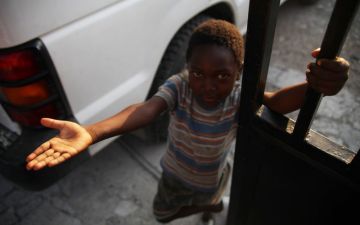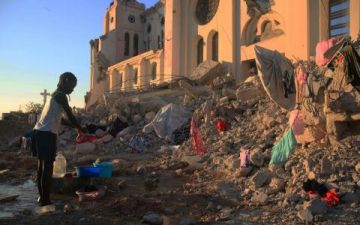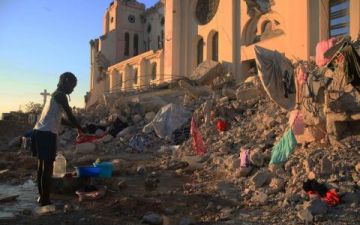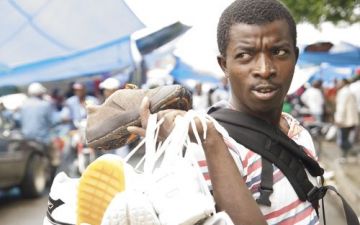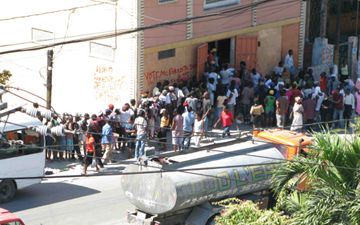Haiti
Haiti: A Nation of Beggars and Slaves?
I thought that things would be different in Port-au-Prince this trip.
Journalist Andre Lambertson Discusses Year-Long Project in Haiti
Andre Lambertson is a photojournalist whose work has appeared in publications such as TIME, US News & World Report and The New York Times Magazine. Previously, Lambertson worked on the Pulitzer Center reporting project "Scars and Stripes: Liberian Youth After the War."
In this interview, Lambertson talks about the significance of working on a year-long reporting project focusing on the rebuilding of Haiti.
Haiti: Evening in Sou Piste
The people of Sou Piste do the same things here, in their new makeshift community, as they did in the places they lived before. As evening falls, girls fetch water, women cook beans and plantains and rice on outdoor fires, and boys use the last moments of light to fly their kites. Many of the 40,000 people living here moved to this old airport runway the night of the earthquake, after their homes were destroyed.
Haiti: Neg Mawon Pap Jamn Kraze
The statue of Neg Mawon sits in the center of Port-au-Prince. It is a symbol of the Haitian people's independence—a sculpture of a black man, his ankles and wrists shackled, though the chains are broken. He is a slave, fighting for his freedom; in his left hand, he holds a conch shell to his lips, blowing to call others to join the revolt.
Haiti: Spontaneous Song at the General Hospital
The General Hospital in Port-au-Prince is guarded by American soldiers with dark sunglasses and frighteningly large guns. Most of the buildings are damaged, so the patients lie outside in large white tents—makeshift wards.
Haiti: A Doctor's First Response
One month ago today, Dr. Louise Ivers was in a meeting at the World Food Programme (WFP) office in Port-au-Prince when the ground began to shake. As first it was just a slight rumble, so that she thought that what she was feeling was perhaps the vibration of heavy construction equipment. But then the ground began to shake so violently that it was hard to stand up. "I fell over," says Ivers. "People started screaming, and we could hear the cracking sounds as the buildings shook and fell."
Haiti: Life Goes On
The center of Port-au-Prince—its palace, ministries, schools and office buildings—lies in ruins. On January 12, the earth shook for less than a minute, but in those 35 seconds, buildings cracked and toppled, floors of concrete collapsing one atop the other, crushing hundreds of thousands of people as they fell.
Dominican Republic: The Border
Mondays and Fridays are market days in Dajabon, the small frontier town in the northwest of the Dominican Republic on the border with Haiti.
Internews: Media Coordinating Relief in Haiti
Haiti's infrastructural devastation in the wake of last week's earthquake highlights media's critical role in facilitating relief efforts. Mark Frohardt knows this all too well. Frohardt is Vice President for Health and Humanitarian Media at Internews, an international media and development organization mandated to empower local media. He and his team arrive in disaster areas at the height of crises to fill gaps in information sharing and provide local media outlets with the necessary tools to rebuild.
Consequences of Inaccessible Water in Haiti
Water has been identified as a top priority for aid to Haiti as it struggles to recover. The consequences of not having access to water extend beyond dehydration. Thirst drives people to water sources they would not have considered before - sources contaminated with human waste, garbage, and industrial byproducts. Using this water leads to diseases like cholera and dysentery, which spread rapidly through communities.
Haiti: Systemic Crises Before and After the Earthquake
This past week, with international focus centered on Haiti, the Pulitzer Center has joined in the global dialogue by drawing attention to the systemic crises that existed in the country before the Jan. 12 earthquake.
We aim to raise awareness of the other issues facing the people affected by this disaster. Our grantees have captured the deplorable conditions of Haiti's national penitentiary, which was among the buildings destroyed by the earthquake, and explored the lives of the child slaves who comprise nearly ten percent of Haiti's youth population.

